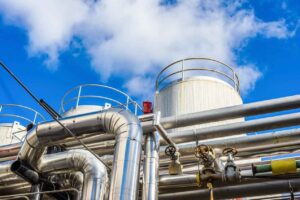Flue gas velocity monitoring is of great significance for environmental monitoring and industrial production management.
Flue gas velocity monitoring helps companies understand their pollutant emissions, strengthen the implementation of pollution prevention and control measures, improve the accuracy and reliability of monitoring data, and provide effective technical support for environmental protection work. By real-time monitoring of flue gas emissions, the volume flow of flue gas can be calculated. These data are used to monitor whether the company’s pollutant emissions meet national standards and take timely measures to control them when they exceed the limit. At the same time, the flue gas velocity meter can also be used to detect the performance of pollution control facilities, determine whether the operating effect of the control facilities meets the requirements, and provide data support for improving emission processes.
Flue gas velocity monitoring plays a vital role in the field of environmental protection. It not only contributes to environmental protection and the sustainable development of industrial production but also provides a scientific basis for the government to formulate environmental protection policies and promotes the development of environmental protection scientific research.
At present, most foreign CEMS use flue gas ultrasonic flow meters to measure the flow rate of flue gas, while most domestic ones use Pitot tube flue gas flowmeters with lower cost and lower measurement accuracy.
The Pitot tube has two pipes for collecting flue gas, one facing the wind (called the dynamic pressure pipe), and the other facing the leeward (called the static pressure pipe). The kinetic energy of the collected flue gas is converted into pressure energy. When there is airflow in the flue, the windward side of the dynamic pressure pipe is impacted by the airflow, so the pressure inside the dynamic pressure pipe is higher, which is called “total pressure”. The static pressure pipe is facing the leeward, and since it is not impacted by the airflow, the pressure inside the pipe is static pressure, called “static pressure”. The difference between total pressure and static pressure is called differential pressure, and its size is related to the flue gas flow velocity (volume) (also called wind speed) in the pipe. The greater the flue gas flow velocity (volume), the greater the differential pressure; the smaller the wind speed (volume), the smaller the differential pressure. Therefore, only by measuring the size of the differential pressure and finding the corresponding relationship between the differential pressure and the wind speed (volume), can the flue gas flow velocity (wind speed) discharged in the pipe be correctly measured.
In the actual measurement, if the humidity on site is too high and the smoke temperature is low, water droplets will directly form and adhere to the sampling port, directly affecting the cross-sectional area of the air inlet, and may even completely block the air inlet, resulting in the test data being 0. If an abnormal zero value occurs, the environmental monitoring platform will issue an alert, and the operation and maintenance will usually perform routine methods such as cleaning crystals and blockages and adjusting the backflush cycle. Under normal circumstances, this may help solve the problem, but for high humidity conditions, conventional treatment methods do not work.
A listed chemical company in Hubei faced this problem and used Siemens Pitot tube + transmitter to measure flue gas flow rate on-site, but abnormal 0 values often appeared.
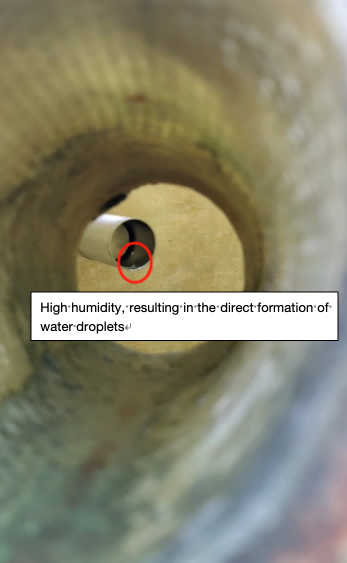
The internal situation of the flue was photographed through the comparison hole
To cope with the on-site working conditions – the on-site smoke temperature is 45 degrees, the humidity is >10%, the chimney diameter is 80cm, and there is only one platform on-site, so it is impossible to use a through-type ultrasonic flowmeter. ESE Technology has launched an integrated ultrasonic flow meter. Unlike the Pitot tube method, the ultrasonic flow meter uses the time difference method during ultrasonic propagation to measure the flow rate of the gas. A pair of ultrasonic probes are used to measure the propagation time of the ultrasonic wave in the downstream and upstream directions of the medium. The propagation time difference represents the flow velocity of the medium between the probes, thereby measuring the flow velocity of the medium.

Working principle diagram of time difference method
This product has the following advantages:
l Suitable for measuring the flow of acidic and water-containing gases, and is not affected by changes in gas components;
l Can measure lower flow velocity, the lower limit of measurement can reach 0.1m/s;
l The measurement range is large, supporting the range of 0.5~20m;
l Single-end installation, more convenient for hole opening;
l The parts of the whole machine that come into contact with the gas are made of corrosion-resistant materials, which can be used to resist the corrosion of flue gas;
l The instrument data processing adopts embedded mode, with functions such as calibration, configuration, query and diagnosis;
The technical team of ESE rose to the challenge, braved the scorching heat, worked overtime to customize equipment, gave up family reunions on holidays, and went to the site to install and debug, helping the company solve the problem of abnormal zero values in flue gas monitoring.
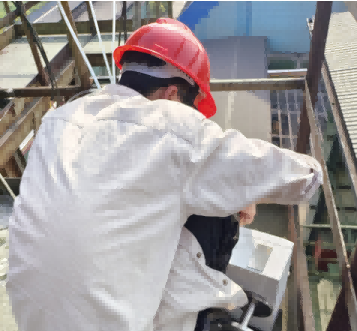
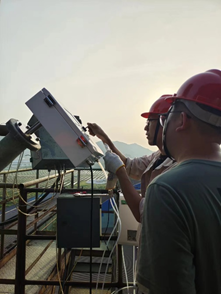
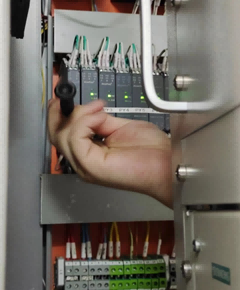
As an effective flue gas flow rate detection equipment, ESE flue gas ultrasonic flowmeter can not only solve the problem of abnormal 0 value, but also can be widely used in the flow rate monitoring of pollution source emission outlets in industries such as petroleum, coal, electricity, natural gas, steel, building materials, chemical industry, petrochemical industry, textile, non-ferrous metals, and waste incineration.




